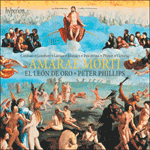
Welcome to Hyperion Records, a British classical label devoted to presenting high-quality recordings of music of all styles and from all periods from the twelfth century to the twenty-first.
Hyperion offers both CDs, and downloads in a number of formats. The site is also available in several languages.
Please use the dropdown buttons to set your preferred options, or use the checkbox to accept the defaults.

from notes by Stephen Rice © 2008
extrait des notes rédigées par Stephen Rice © 2008
Français: Hyperion Records Ltd
aus dem Begleittext von Stephen Rice © 2008
Deutsch: Renate Wendel
 Amarae morti Amarae mortiFrom darkness to light: Peter Phillips’ journey enlists some of the greatest names from across Renaissance Europe.» More |
 Journeys to the New World Journeys to the New WorldAn album of gorgeous late-Renaissance polyphony from composers Cristóbal de Morales, Hernando Franco, Tomás Luis de Victoria, Francisco Guerrero, Alonso Lobo, Juan Gutiérrez de Padilla, Francisco López Capillas and Miguel Mateo de Dallo y Lana.» More |

